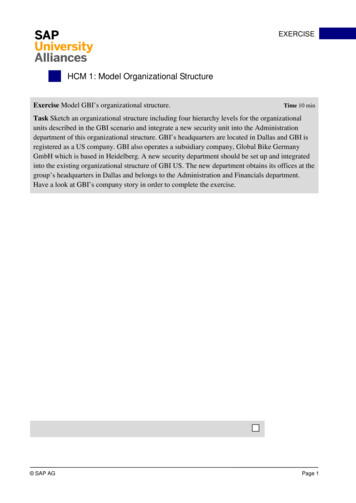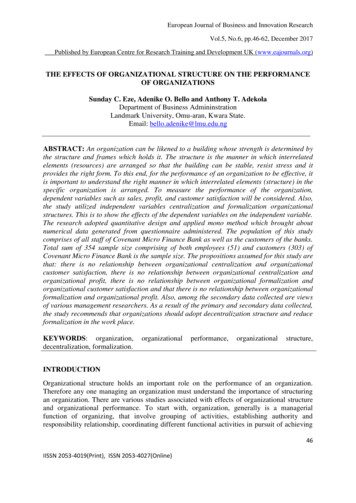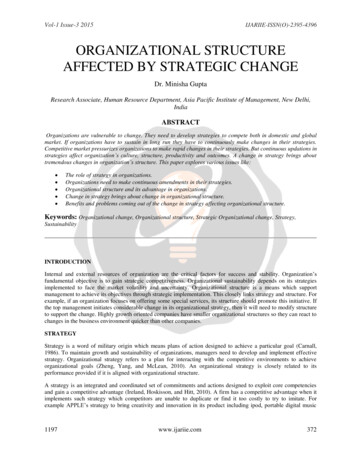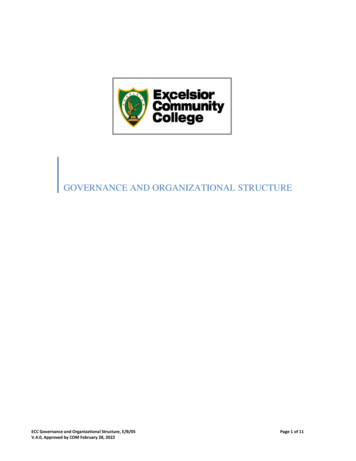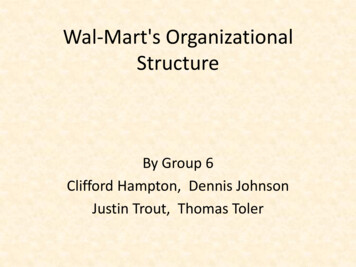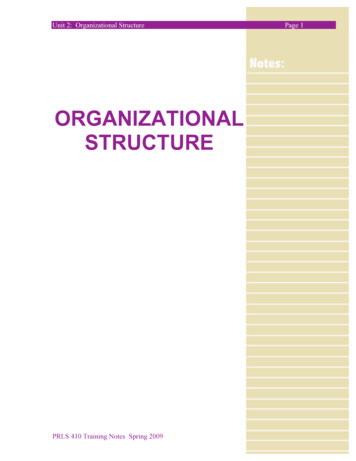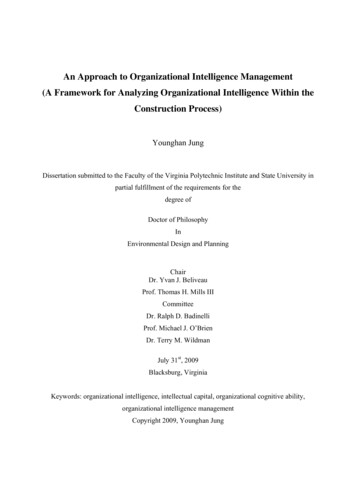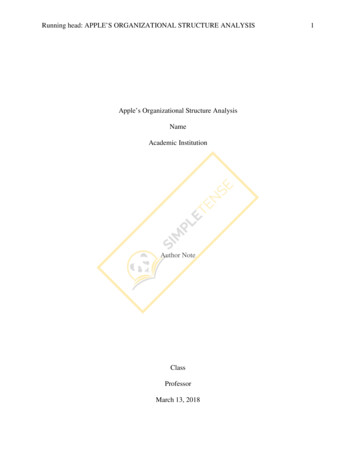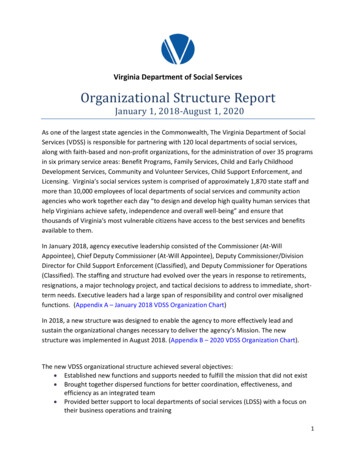
Transcription
Virginia Department of Social ServicesOrganizational Structure ReportJanuary 1, 2018-August 1, 2020As one of the largest state agencies in the Commonwealth, The Virginia Department of SocialServices (VDSS) is responsible for partnering with 120 local departments of social services,along with faith-based and non-profit organizations, for the administration of over 35 programsin six primary service areas: Benefit Programs, Family Services, Child and Early ChildhoodDevelopment Services, Community and Volunteer Services, Child Support Enforcement, andLicensing. Virginia’s social services system is comprised of approximately 1,870 state staff andmore than 10,000 employees of local departments of social services and community actionagencies who work together each day “to design and develop high quality human services thathelp Virginians achieve safety, independence and overall well-being” and ensure thatthousands of Virginia's most vulnerable citizens have access to the best services and benefitsavailable to them.In January 2018, agency executive leadership consisted of the Commissioner (At-WillAppointee), Chief Deputy Commissioner (At-Will Appointee), Deputy Commissioner/DivisionDirector for Child Support Enforcement (Classified), and Deputy Commissioner for Operations(Classified). The staffing and structure had evolved over the years in response to retirements,resignations, a major technology project, and tactical decisions to address to immediate, shortterm needs. Executive leaders had a large span of responsibility and control over misalignedfunctions. (Appendix A – January 2018 VDSS Organization Chart)In 2018, a new structure was designed to enable the agency to more effectively lead andsustain the organizational changes necessary to deliver the agency’s Mission. The newstructure was implemented in August 2018. (Appendix B – 2020 VDSS Organization Chart).The new VDSS organizational structure achieved several objectives: Established new functions and supports needed to fulfill the mission that did not exist Brought together dispersed functions for better coordination, effectiveness, andefficiency as an integrated team Provided better support to local departments of social services (LDSS) with a focus ontheir business operations and training1
FunctionsThe Executive Team is a cross-collaborative leadership team consisting of the Commissioner,Chief Deputy Commissioner, Chief of Staff and the Deputy Commissioners of key programsareas: Technology, Administration, Human Services, State Programs, and Strategy andEngagement. This Executive Team shares ownership of the agency’s effectiveness and buildsmutual accountability across the organization. The team shapes strategies, develops objectivesand collectively resolves issues that are critical to the overall agency performance. Theyoversee processes for strategic planning and are tasked with critical decision-making that willadvance the agency towards organizational goals. All Deputy Commissioners and Chief of Staffare civil servants, ensuring continuity of operations across administrations.Technology –This change creates a single portfolio that consolidates lines of business that focuson technology and systems with an integrated vision and oversight to promote alignment andefficiency. This grouping of like lines of business promotes collaboration and streamlinedefforts designed to achieve common agency goals. It includes project planning, budget andoversight, administration of all IT systems, applications and operations and incorporates thefollowing Divisions: Enterprise Business Solutions focuses on VDSS enterprise information technologyprojects, with an emphasis on self-service benefits and services models that areefficient, effective, and customer friendly. Application Development provides solutions to meet the app (software application orprogram) development requirements of various business divisions of VDSS. Infrastructure Operations provides support and ongoing management for technologyused by the agency's 10,000 staff statewide. This includes IT operations management,customer support, asset and change management, and Virginia Information TechnologyAgency (VITA) coordination. Information Security & Risk Management protects VDSS information systems byaddressing security compliance, risk, and opportunities in alignment with VDSS andstakeholder objectives.Administration - Lines of business that provide operational support to the entire agencythrough the following divisions: The Division of Finance provides management and oversight of the agency’s financialoperations. This includes providing financial guidance, along with establishing formalpolicies and procedures for both VDSS and local departments, as well as ensuring fiscalcompliance with state and federal regulations. The Division of General Services provides management and oversight of the agency’scontracts and procurement, internal technical assistance and guidance to agencypersonnel regarding property and facilities management, and support theCommonwealth's emergency management efforts for state shelters. The Organizational Development Division is focused on creating a positiveorganizational culture and supporting the acquisition, management, development,2
engagement, retention, and well-being of a qualified and productive workforce. Thedivision serves both state and local employees and managers.Human Services –Lines of business that collaborate as a team to support local departments andtheir customers. Local departments are county and city government departments of socialservices for which VDSS hat both oversight responsibility as well as training, technology andtechnical assistance responsibilities. Program staff focuses on policy development, programdesign and assessing program outcomes. The Division of Family Services promotes safety, permanency and well-being forchildren, families and individuals in Virginia through program areas that includeadoption, foster care, child protective services, abuse prevention and more. The Division of Benefit Programs is responsible for the supervision and management of16 public assistance programs (SNAP, TANF, Energy Assistance, etc.) that provideincome support benefits and employment services to families and individuals in theCommonwealth. A new Workforce Services function was created in this division toprovide comprehensive workforce services to all those that touch our system. The Division of Child Care and Early Childhood Development enhances the quality,affordability, and supply of child care in Virginia by operating the child care subsidyprogram, implementing a quality rating system, and providing professional developmentfor child care workers. Local Engagement & Support is comprised of staff at the VDSS home office and fiveregional offices across the Commonwealth. Teams work collaboratively across eachlocation to support Virginia Social Services System initiatives by consulting andsupporting Local Departments of Social Services. Workforce Development & Support is a new program training function that wasestablished to deliver centralized, coordinated training across all Human Servicesprograms to state and local employees.State Programs – The following lines of business, within VDSS, provide support and services atthe state level (not via local departments). The Division of Child Support Enforcement is responsible for ensuring that Virginia'schildren receive financial support by reaching noncustodial parents, establishing andenforcing child support obligations, supporting parents with family-centered resources,and collecting and disbursing payments. A Division Director position was established tolead this division. The division leadership role was previously incorporated in the DeputyCommissioner position. The Division of Licensing Programs protects the safety, health and well-being of childrenand adults receiving care in non-medical day and residential programs through thelicensing of adult and children’s programs. The Children and Adult functions wereconsolidated under a single Division Director. Business Operations is comprised of the Office of Background Investigations supportedby Licensing Programs and the State Disbursement Unit supported by Child SupportEnforcement) for VDSS. The Office of Background Investigations provides backgroundinvestigation searches of individuals with founded cases of child abuse or neglect, aswell as criminal fingerprint records searches for barrier crimes. The State Disbursement3
Unit collects child support funds for the Commonwealth of Virginia, documents thosecollections in the statewide automated system and disburses those funds to custodialparents.Strategy & Engagement – This portfolio was established to create a focus and enhance theagency’s ability on developing and driving human services strategies and strategic projects toshape the future of the social services system across the Commonwealth of Virginia. The Division of Community & Volunteer Services (CVS) maintains close relationshipswith community organizations, faith-based organizations, non-profits and localdepartments of social services to enable Virginia’s social services system to poolresources and provide a safety net for services. CVS also implements the federalCommunity Services Block Grant through the 31 Community Action Agencies in Virginia,as well as the services offered by the Refugee Resettlement Program operated throughits six refugee resettlement program providers. The Office of Innovation & Strategic Initiatives – A new division established to identifyand deploy best practices as well as leverage human centered design and innovation torapidly develop and test innovative strategies and methodologies. This divisioncollaborates with the broader social services system, community based organizations,other state agencies, and nontraditional partners to implement innovation projects andstrategic initiatives that will increase the agency’s capacity to better achieve its mission. The Office of Research & Planning – Elevates the agency’s capability in all lines ofbusiness in researching, reporting and using data for program evaluation, processimprovement, forecasting, risk management and decision-making. It provides researchexpertise and fulfills data requests for state and local social services staff to supportplanning, evaluation, decision -making, and compliance with state and federal reportingrequirements.Compliance – Independent from all lines of business, this newly established function separatedoversight responsibility from program operations. This function is responsible for agency-widecompliance and risk mitigation that helps to ensure adherence to state and federal legal andregulatory standards, including Appeals and Fair Hearings, Quality Control, Freedom ofInformation Act and Sub-recipient Monitoring, cooperation with OSIG investigations, FOIA, andoversight of fraud investigation activities.Legislative & Regulatory Affairs is responsible for providing oversight of all legislative andregulatory activities of VDSS, including monitoring legislation during each General Assemblysession, coordinating year round regulatory activities and assuring departmental compliancewith state and federal mandates.ChangesIn addition to the 2018 structure changes described above, the following changes have beenmade at the leadership level in the past twelve months.4
o Filled the at-will Chief Deputy Commissioner position and changed the reportingrelationship of the Compliance function from the Commissioner to this position.o Established the Office of the Chief of Staff and filled a Chief of Staff position – This Officewas established to drive the execution of key internal and inter-agency priorities, crossfunctional project coordination, sound administrative and communications processes, andto provide strategic leadership to the agency in efforts to build capacity, improve customerexperiences and ensure organizational effectiveness. It also oversees the Public Affairs &Communications function. Public Affairs – Supports public relations, communications and digital solutions andprovides comprehensive internal and external communications services througheducation, awareness and outreach efforts to employees, community partners, themedia and the public citizens, including management of VDSS’ public and internalweb portals.o Established an Assistant Deputy of Human Services position. All support functions relatedto the local departments of social services are now solely under the authority of thisposition. Additionally, a training division was established within this portfolio to support theprograms.o As part of the integration and reorganization of the Information Technology Servicesfunction, established a Deputy Chief Information Officer (CIO) position, and establishedDivision Director positions for the Application Development and Infrastructure OperationsDivisions.o Established the Information Technology Investment Council (ITIC) responsible for theoversight and delivery of all investment decisions, to ensure the effective and efficient useof technology in enabling VDSS to achieve its strategy and goals within acceptable levels ofrisk. The Council is accountable for ensuring that technology services deliver business valueand an excellent customer experience and that expected benefits from new investmentsare fully realized. (Appendix C – Information Technology Investment Council)A list of current agency full-time and part-time positions, by job title, is available in Appendix D.5
Appendix AJanuary 2018OperationsDeputy CommissionerChild Care &EarlyChildhoodDevelopmentDivisionDirector Sr.Division ofLicensingAdult LicensingDiv. Director Sr.Children’sLicensingAppeals & FairHearingsDivisionDirectorCommunity &VolunteerServicesDivisionDirector Sr.CommissionerFamily ServicesDivision Director Sr.Child SupportEnforcementDeputy Commissioner/Division Director Sr.Legislative AffairsDivision Manager Sr.Benefit ProgramsDivision Director Sr.Chief nDirector Sr.InformationSystemsDivisionDirector Sr.FinanceChief rGeneralServicesDivisionDirectorResearch &PlanningDivisionDirectorDiv. Director Sr.Public rector Sr.Regional Ops andLocal SupportDivision Director Sr.
Appendix BEXECUTIVE TEAMVIRGINIA D EPARTMENT OF SOCIAL SERVICES ORGANIZATIONAL CHARTDuke StorenNecole SimmondsChief Deputy CommissionerGena BergerLegislative & Regulatory AffairsPublic AffairsKarin Clark ComplianceRoss McDonaldDeputy CommissionerTechnology, CIODeputy CommissionerAdministrationDeputy CommissionerHuman ServicesDeputy CommissionerState ProgramsDeputy C ommissioner Strategy & EngagementRoland RiveraJoseph JeuNannette BowlerCraig BurshemHari DulalDeputy Chief Information OfficerFinanceChild Support EnforcementCommunity & Volunteer ServicesBarbara LacinaFran IngeLicensing ProgramsInnovation & Strategic InitiativesKevin PlateaDIVISIONSCommissionerChief of StaffEnterprise BusinessSolutionsDeborah VaughnApplication DevelopmentVacantIda WitherspoonGeneral ServicesMichele SkaggsOrganizational DevelopmentAssistant Deputy ofHuman ServicesRyan KellyBenefit P rogramsToni Blue WashingtonChild Care & EarlyChildhood DevelopmentBarbara NewlinBusiness OperationsPeter FinnStephanie LarsonInfrastructure OperationsTara Davis-RaglandFamily ServicesVacantKristin ZagarInformation S ecurity &Risk ManagementLocal Engagement &SupportBarry DavisAngela MorseAndrea Gregg, InterimOffice of Research & P lanningJeff Price
Virginia Department of Social ServicesVDSS IT Governance CharterJuly 14 2020, version 2.0 — Page 1Virginia Department of Social ServicesInformation Technology Governance CharterJuly 31, 2020, version 3.0TABLE OF CONTENTSGovernance Charter .2Purpose .2Authority .2Council Membership .3Council Chair .3Consensus Decision Making .4Responsibilities of the IT Investment Council .4Responsibilities of the CIO .6Responsibilities of the Line of Business (LOB) Executives .7Responsibilities of Others .7IT Investment Council Structure .8Tertiary Councils .8Exception Process .9Meetings and Types of Decisions .9Additional Topic-Specific Meetings .10Monthly Meetings .10Annual Meetings .10Appendix A VaCMS Steering Committee Charter .111.0Executive Summary / Purpose .112.0Authority .122.1Authority Structure .123.0 Membership .123.1 VaCMS Steering Committee .123.2 VaCMS Working Group .134.0 Responsibilities .134.1 VaCMS Steering Committee .134.2 VaCMS Working Group .145.0 Reporting .14[1]Appendix C
Virginia Department of Social ServicesVDSS IT Governance CharterJuly 14 2020, version 2.0 — Page 2LIST OF FIGURESFigure 1. Investment Life Cycle .3Figure 2. Consensus Process Steps .4Figure 3. Investment Life Cycle Process .4Figure 4. Investment Council Structure .7Governance CharterPurposeThe IT Investment Council (Council) is responsible for the oversight and delivery of all IT investmentdecisions in support of the overall strategic direction of the Virginia Department of Social Services (VDSS)established by the Executive Team. The purpose of the Council is to ensure the effective and efficient useof technology in enabling the VDSS to achieve its strategy and goals within acceptable levels of risk. TheCouncil is accountable for ensuring that technology services deliver business value and an excellentcustomer experience and that expected benefits from new investments are fully realized. The Council willalso adhere to the concepts and frameworks for Project Portfolio Management (PPM), which is thecontinuous process of identifying, selecting and managing a portfolio of projects in alignment with keyperformance metrics and strategic business objectives.The Council will make decisions by discussing items or issues and coming to agreement. This agreementdoes not necessarily mean that each member concurs with the decision itself, but rather, supports thedecision and will visibly demonstrate that support in the public arena within VDSS.AuthorityThe VDSS IT Governance Charter is established in accordance with COV ITRM Policy GOV 105-05(TECHNOLOGY MANAGEMENT POLICY) dated July 9, 2018, which provides a recommended practicebase IT portfolio management methodology that is used to support both the selection of new agency ITinvestments and the evaluation of operational IT investments based on criteria established by the CIO.VDSS will also comply with the Commonwealth Information Technology Investment Management (ITIM)process described in the Information Technology Resource Management Standard posted on the VirginiaInformation Technology Authority (VITA) website ary/PSGs/ITRM Policy GOV102 01 july09.pdf The ITIMprocess follows the investment life cycle: Select and prioritize the best IT investments in line with the goals of the agency.Access the ability to move forward based on VITA procedures and agency resources.Develop and implement the plan; ensure stringent oversight of the projects.[2]
Virginia Department of Social ServicesVDSS IT Governance CharterJuly 14 2020, version 2.0 — Page 3 Measure and evaluate IT investment costs, risks and benefits prior to selection and afterimplementation.Figure 1. Investment Life CycleCouncil MembershipThe Council is composed of leaders in the enterprise: Commissioner, Duke Storen Chief Deputy Commissioner, Gena Boyle Berger Chief of Staff, Necole Simmonds Deputy Commissioner for Technology / Chief Information Officer, Roland Rivera Deputy Commissioner for Administration, Joseph Jeu Deputy Commissioner for Human Services, Nannette M. Bowler Deputy Commissioner for State Programs, Craig Burshem Deputy Commissioner for Strategy and Engagement, Hari Dulal Chief Financial Officer, Ida Witherspoon Director of General Services, Michele Skaggs (non-voting member) Chief Information Officer of the Commonwealth, Nelson P. Moe, or his designee (non-votingmember) President, League of Social Services, Andy Crawford or his designee (non-voting member)Council ChairThe Chief Deputy Commissioner will chair the Council. The Chief Information Officer is the backup to theChief Deputy Commissioner.[3]
Virginia Department of Social ServicesVDSS IT Governance CharterJuly 14 2020, version 2.0 — Page 4Consensus Decision MakingConsensus decision making is a creative and dynamic way of reaching agreement among all members ofa group. Instead of simply voting for an item and having the majority of the group determine the outcome,a group using consensus is committed to finding solutions that everyone actively supports or can at leastlive with. This ensures that all opinions, ideas, and concerns are taken into account. The group aims tocome up with proposals that work for everyone by listening closely to each other.The goal of consensus decision making is to dismantle hierarchy of any kind and replace it with sharedpower. It is based on the values of equality, freedom, co-operation, and respect for everyone's needs.The benefits of consensus include sharing power, building a strong IT investment council, making betterdecisions, getting things done, protecting minority needs and opinions, and building strong relationships.The IT Investment Council shares VDSS’s goals and is committed to working together towards achievingthose goals. We are committed to reaching consensus by agreeing to the principles of trust andopenness, taking the time necessary to come to consensus, supporting the consensus process (seefigure 4), and actively participating in order to come to a decision together.The Chief of Staff shall facilitate the consensus decision-making process.Figure 2. Consensus Decision Making ProcessResponsibilities of the IT Investment CouncilThe Council ensures that the IT investments are aligned with the business strategy for the enterprisewithin acceptable levels of risk. Although the IT Strategic Planning process begins with technologyportfolio analysis, the agency will continuously manage and evaluate the technology portfolio. The graphic[4]
Virginia Department of Social ServicesVDSS IT Governance CharterJuly 14 2020, version 2.0 — Page 5below shows the life cycle of the IT Investment Management (ITIM) process, which relies on analysis ofthe agency portfolio.Figure 3. Investment Life Cycle ProcessResponsibilities include: Decide on agency IT strategies, objectives and capabilities of the enterprise. Review andapprove a portfolio of assets and investments for the enterprise and align technology servicesand investments with the VDSS strategy and the IT portfolio. The CIO will recommend and the Council shall approve a five-year IT Strategic Plan. TheCouncil will approve changes to the plan as necessary and document the end-state in the to-beArchitecture. Integrate the five-year plan into the Enterprise Architecture in the form of a to-beArchitecture to help identify capability-gaps that need to be filled and resourced in the plan. Determine the IT investment approach. Create investment principles that serve to guideinvestment decisions for the enterprise. Determine funding sources and financial authority andestablish audit responsibilities and accountabilities. Balance IT investment risk against potential investment opportunities, selecting thoseinvestments that are in line with the risk profile of the enterprise. Ensure a steady flow of communications. Communicate IT strategy and investment decisions toemployees and stakeholders (State Board of Social Services, Department of Planning andBudget (DPB), VITA, VDSS, and local departments of social services) to create understanding atall levels of the enterprise about the investments that have been approved. Communicatechanges to the VDSS strategy that may have an impact on technology services. Deliver results. Balance the agile process and structured development approaches tosuccessfully manage both large, complex distributed IT projects and small, co-located ITprojects. Ensure the progress of technology projects, services and investments at the strategiclevel is successful. Resolve issues that impede the effective delivery of investments. Ensureenterprise and technology strategies align and that deviations are intentionally managed. Improve IT governance. Continuously assess the effectiveness of the governance process andof the IT Investment Council and make changes to improve the process and effectiveness andprevent chaotic or reckless behavior on the part of the enterprise and its people.[5]
Virginia Department of Social ServicesVDSS IT Governance CharterJuly 14 2020, version 2.0 — Page 6 The IT Investment Council will meet monthly for the remainder of 2019 and during 2020.Beginning in January 2021, the Council will meet quarterly. A quorum is a simple majority of the IT Investment Council members. Meetings will include members, member designees, and invited subject matter experts orguests. Members of the IT Investment Council will make decisions through consensus. The IT Investment Council recognizes that failure of members to attend meetings will resultin issues. The IT Council Chair and/or the Commissioner will discuss non-attendance withmembers if necessary and try to re-engage them in the Council. Design Council meetings toengage members to use their expertise and participate in making meaningful decisions.Responsibilities of the CIOThe CIO ensures that the technology strategy is consistent with the business strategy and meets theneeds of other lines of business.Responsibilities include: Deliver a compelling vision of a future target state for IT and the road map to get there inmanageable steps. Resolve cross-functional issues within the technology strategy. Implement the technology strategy. This includes recommending a five-year IT Strategic Plan. Ensure the enterprise architecture represents the agency direction and strategy, as well asincorporates new and relevant technologies as appropriate to advance the VDSS mission. Establish and maintain a current asset portfolio of hard assets like production applications,hardware, tools and staff linked to soft assets such as business processes, data, hosted services,supporting applications, capabilities, knowledge, and skills. Maintain this in both as-is, and to-beEnterprise Architecture models and present to the Council annually. An Enterprise Architecture should inform IT leadership on at least four questions: what do I have,where is it, what is on it, and what business process does it support? There should be a processto inform the future-state vision of the Enterprise Architecture, of which IT is a component. Thereshould a process that informs the future-state vision of the Enterprise Architecture, of which IT isa component. Maintain and manage an IT project
In 2018, a new structure was designed to enable the agency to more effectively lead and sustain the organizational changes necessary to deliver the agency's Mission. The new structure was implemented in August 2018. (Appendix B - 2020 VDSS Organization Chart). The new VDSS organizational structure achieved several objectives:
